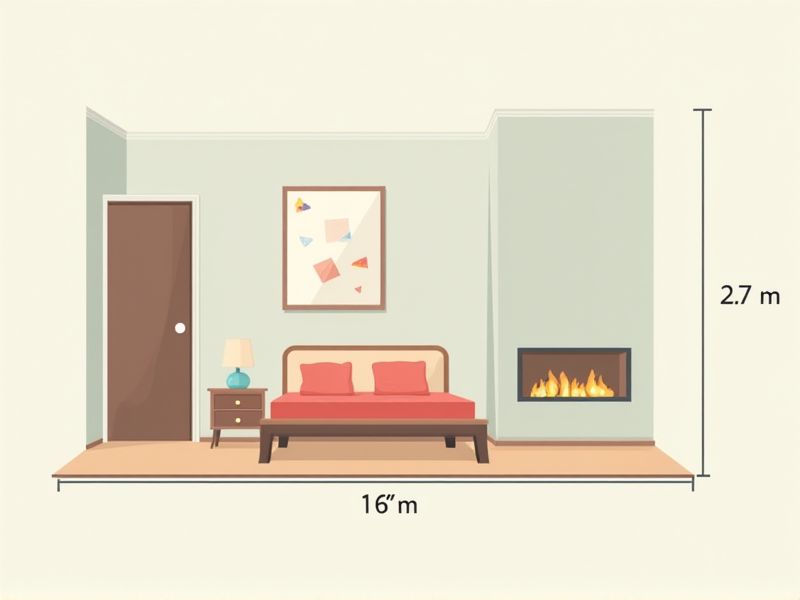
Understanding the standard dimensions of a typical room can be helpful when planning furniture layouts, renovations, or new construction projects. In general, a standard bedroom is often around 10 feet by 12 feet (about 3 meters by 3.6 meters), which provides enough space for essential furniture like a bed, dresser, and desk. Living rooms are usually larger, commonly measuring 12 feet by 18 feet (approximately 3.6 meters by 5.4 meters) to comfortably fit seating arrangements and entertainment centers. However, exact dimensions may vary depending on local building codes, architectural preferences, and the purpose of the room, so it is always wise to consult specific guidelines for your region or project.
Room Length
A standard room typically measures around 300 square feet, with a length of approximately 20 feet and a width of 15 feet. This design provides sufficient space for essential amenities, including a queen-sized bed, a desk, and a small seating area. The room's length allows for optimal flow and arrangement of furniture, enhancing your overall comfort. Many standard rooms also incorporate features like large windows, offering natural light that further contributes to the spacious feel.
Room Width
A standard hotel room typically spans a width of around 12 to 15 feet, providing sufficient space for essential furnishings. The layout often includes a queen or king-sized bed, a nightstand, and a desk area, maximizing comfort within the room's dimensions. Adequate width helps facilitate movement, allowing easy access to amenities like closets and bathrooms. Your experience may vary depending on the specific hotel brand and location, as some may offer more spacious accommodations for an enhanced stay.
Ceiling Height
The standard ceiling height for a room typically ranges between 8 to 10 feet, providing ample space for air circulation and natural light. In residential spaces, an 8-foot ceiling is commonly accepted for functionality, while designs incorporating 9 to 10 feet are favored for a more spacious feel. Higher ceilings can enhance your room's aesthetic, making it appear larger and more open, which is especially beneficial in areas designed for gatherings. For optimal design and comfort, consider how furniture placement and room function interact with your ceiling height choice.
Door Dimensions
The standard dimensions for a hotel room door typically measure 80 inches in height and 36 inches in width, providing ample access for guests and luggage. In terms of thickness, the door usually ranges from 1.75 inches to 2 inches, ensuring durability and security. Door frames are commonly constructed to fit these dimensions precisely, enhancing sound insulation and overall aesthetics of the room. Your understanding of these measurements can help in assessing room accessibility and compliance with building codes.
Window Size
A standard room typically features a window size of approximately 36 inches by 48 inches, allowing for ample natural light while providing a view of the outside. The positioning of the window often contributes to the overall ambiance and energy efficiency of the space. Larger windows, such as those measuring 60 inches by 48 inches, can enhance ventilation and create a more open feel. Ensuring your room maximizes window size can significantly improve your comfort and aesthetic appeal.
Furniture Arrangement Space
A standard hotel room typically spans around 300 square feet, designed to maximize both comfort and functionality. The furniture arrangement prioritizes space efficiency, often featuring a queen- or king-sized bed, a desk, and a small seating area. Nightstands and lamps are strategically placed to enhance accessibility and create a cozy atmosphere. With optimal spacing, you can easily navigate the room while enjoying a well-organized environment conducive to relaxation or work.
Minimum Area Per Person
The minimum area per person for a standard room typically ranges from 100 to 150 square feet, ensuring sufficient space for movement and comfort. This standard accommodates essential furnishings, such as a bed, a desk, and storage, all while promoting a conducive environment for relaxation. Adhering to these space requirements is crucial for both residential and commercial settings, affecting occupancy rates and guest satisfaction. For your design projects, consider these dimensions to optimize functionality and enhance user experience.
Accessibility Clearance
The standard for an accessible hotel room typically requires a minimum clearance of 32 inches for doorways and a floor space of at least 60 inches in diameter to accommodate mobility devices. Bathrooms must feature a roll-in shower or a tub with grab bars, ensuring a secure and safe experience for users with disabilities. The height of facilities, such as light switches, controls, and sinks, should range between 15 to 48 inches to cater to different accessibility needs. By adhering to these guidelines, you can create a more inclusive environment, ensuring that all guests feel welcome and comfortable during their stay.
Ventilation Requirements
Standard room ventilation requirements emphasize maintaining a specific air change rate to ensure indoor air quality. Typically, a minimum of 15 cubic feet per minute (CFM) per person is recommended for adequate ventilation in commercial spaces. Proper ventilation systems should allow for at least five to six air changes per hour in residential settings. Your adherence to these standards can significantly enhance comfort and reduce the risk of airborne contaminants.
Lighting Accommodation
The standard room typically features multiple light sources, including ambient, task, and accent lighting, which together create a versatile atmosphere. Approximately 300 to 500 lumens per square meter is recommended for effective illumination, ensuring both functionality and comfort. With adjustable lighting options, such as dimmers and bedside lamps, you can customize the brightness to suit your needs. This thoughtfully designed lighting not only enhances the aesthetic appeal of the room but also promotes relaxation and productivity.
